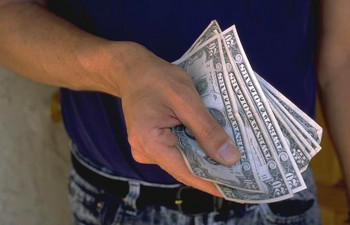How to Identify Counterfeit Money
If you’re afraid that someone is going to slip you a counterfeited $20 bill, you can learn how to identify counterfeit money with a few easy-to-remember tips. People working in retail often have to pay for the money lost when customers steal from the store, so identifying fake money is important for employees of retailers.
Even if you’re a customer, you want to know whether you’re holding counterfeit dollars, because if you pass them on and the cashier notices, you’re going to have to talk to the authorities about why and how you are carrying fake currency. It’s hard to prove a negative, so it’s not always easy to prove to the FBI that you’re a victim, not a counterfeiter. So it pays to be able to spot counterfeit U.S. currencies.
Identifying Counterfeit Money
Here are a few things to check, when identifying counterfeit money.
Paper Quality
U.S. paper currency has a particular consistency. The paper is made of 75% cotton and 25% linen, so American dollars have a particular look and feel. Test out money you know is real and gets used to the texture. Most counterfeits are clever copies, but copies nevertheless.
Micro Fibers Woven into the Paper
U.S. money has blue micro-fibers and red micro-fibers woven into the paper, usually along the ends of the money. Holding up a $20 bill to the light reveals this microfiber in real paper currency.
Counterfeiters attempt to copy this feature, but most of them imitate the effect by placing ink on the surface, instead of treads woven into the paper itself.
Bill Denomination Micro Thread
Also, different denomination dollar bills have the denomination woven into the thread, a little closer to the center of the bill. Holding this bill up to the light lets you see this writing. For instance, a $20 bill is going to have the words “USA Twenty” on it.
Dead Presidents

How to Identify Counterfeit Money
Most have an image that is unique to the denomination of the money, often a second, smaller picture of the president on the front. The $20 has a smaller picture of Andrew Jackson on the left, if you turn look at the backside of the bill, while holding it up to the light.
Clear Pictures
Real U.S. paper money is going to have perfect images that are clear and sharp, because these are inspected before getting into circulation. Fake money often is blurry or the pictures aren’t as clear as they should be. If money looks dull, but is clearly new, that’s a sign it’s counterfeited.
Serial Numbers
Serial numbers on a real dollar bill are going to be evenly spaced and of the same color as the Treasury Seal. If the serial numbers don’t line up, that’s a bad sign.
Color Shifts
In recent years, the Treasury Department has begun using color shifting ink in the right hand lower corner of the bill. The ink tends to shift from a copper or gold color to a black or green color, according to the angle you’re looking at the money from.
Uniform Size and Features
All U.S. treasury bills are going to be uniform size that will line up, if you put them together. They are also going to have uniform features that are going to line up, if you stack them.
Counterfeit Bill Pens
Finally, if you really want to know whether a dollar bill is counterfeit, there are special pens you can buy that detect fake money immediately. Many businesses now have these counterfeit spotting resources.
Identifying Counterfeit Money
If you are offered money that doesn’t look right, don’t accept it. If something looks funny, but you aren’t sure, check for other signs of counterfeiting listed on this page. Counterfeiters are usually going to get a few things right, but it’s hard to get everything perfect, which is why the U.S. money printers go to such great lengths to add different touchstones.
Knowing how to identify counterfeit money is knowing each of these tip-offs, so you can check suspicious money a half-dozen different ways.
